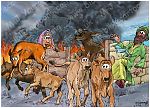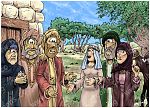Bible Cartoon: <-- Malachi : Matthew -->
Click on Add to cart button below shopping cart.
Purchased Bible Cartoons do not have watermarks. Links to Cartoons provided on email once purchase is completed.Matthew
Book type: Gospel
Author: The apostle Matthew, the son of Alphaeus (aka Levi)
No. of chapters: 28
Key character(s): God, Jesus, Mary (mother of Jesus) and Joseph, John the Baptist, the 12 apostles/disciples, Mary Magdalene, Caiaphas, Pontius Pilate. [1]
Brief description: Matthew: – The King & His kingdom.
01) Jesus’ birth fulfilled prophecy (1:1-2:23)
02) The obedient Jesus invites people to kingdom service (3:1-4:25)
03) Jesus taught God’s way to live (5:1-7:29)
04) Jesus power & call reveal his authority (8:1-10:42)
05) Jesus’ work led to controversy (11:1-12:50)
06) Jesus taught about the kingdom (13:1-52)
07) Jesus confronts conflict & critical events (13:53-17:27)
08) Jesus gives insight into life in his kingdom (18:1-20:34)
09) Religious authorities reject Jesus as Messiah (21:1-23:36)
10) Jesus has the authoritative word about the future (23:37-25:46)
11) Jesus prepared for death, obeying God & fulfilling scripture (26:1-56)
12) Jesus conquered death (26:57-28:20)
The name Matthew occurs in two forms Ματθαῖος, Matthaíos, and Maththaíos, & is a Greek reproduction of the Aramaic word Mattathyah, i.e. “gift of Yahweh,” and is equivalent to Theodore.
The word gospel is derived from the Anglo-Saxon word which meant “God’s spell”, or “God’s word”, ie “the story concerning God.” In the New Testament the Greek word euaggelion, means “good news.” It proclaims tidings of deliverance.
Mark’s Gospel had already been written by the time Matthew penned his. Helpful though it was, the Gospel of Mark did not include many of Jesus’ teachings. Matthew sought to remedy the situation.
Matthew wrote for people who had at least 3 religious options:
01) They could accept or reject Jesus as the promises Jewish Messiah. Most Jews did reject him as Messiah, though some did become believers.
02) They could live strictly according to the Jewish law, as the Pharisees taught. They could, in other words, be legalists, even if they had already become Christians.
03) They could decide that because they were Christians the law was no longer necessary for them. They would, therefore, live as they pleased, without any moral rules.
Theological conclusions.
The book of Matthew puts emphasis on 4 doctrines to give certainty to a questioning church:
01) Jesus is the Messiah prophesied by scripture.
02) Jesus’ teachings are the new law for the church.
03) The kingdom of heaven is both present & future reality.
04) The church is the new community of faith.
Only Matthew of the 4 Gospel writers included teachings about the church.
b>Contemporary teaching.
The Gospel of Matthew focuses our attention on Jesus, making our response to him the main issue.
[Source: NIV Disciple’s Study Bible]
Matthew was not written to chronicle the events of Jesus’ life, but rather to present the undeniable evidence that Jesus Christ is the promised Saviour, the Messiah, the King of kings and Lord of lords. It begins by accounting the genealogy of Jesus, then his birth, baptism and public ministry. The miracles recorded in Matthew reveal Jesus’ authority and true identity.
[Source: http://christianity.about.com/od/newtestamentbooks/qt/MatthewIntro.htm]
Key Verse(s):
Matthew 4:4 (ANIV)
Jesus answered [the Devil, during his temptation in the Judean desert], “It is written: ‘Man does not live on bread alone, but on every word that comes from the mouth of God.’ “
Matthew 5:17 (ANIV)
[Jesus said] “Do not think that I have come to abolish the Law or the Prophets; I have not come to abolish them but to fulfil them.”
Matthew 10:39 (ANIV)
[Jesus said] “Whoever finds his life will lose it, and whoever loses his life for my sake will find it.”
[1]
Fuller list of major characters in the Matthew’s Gospel:
| Name | Notes |
| Jesus | ”Saviour”. Christ means “the Anointed One”. (aka Jesus of Nazareth, The Christ, The Messiah, Son of man, Son of God). The central figure of the New Testament, whose life, death, and resurrection are chronicled in the 4 Gospel books. |
| Mary (mother of Jesus) | Greek. Maria or Mariam; from Hebrew miryam, “obstinacy, rebellion”. Young virgin mother of Jesus. Impregnated by the Holy Spirit. One of the only people who remained with Jesus through the crucifixion. |
| Joseph | jo´zef; “may he,” i.e., Jehovah, “add”. Mary’s husband & step-father of Jesus. Of direct paternal descendent from King David, which makes Jesus an heir to the Davidic line. |
| John the Baptist | Jon; Greek ’Ioannes; from Hebrew Yôhanan, “Jehovah is gracious”. Son of Zechariah & Elizabeth. The forerunner to Jesus, spreading the word of Jesus’s imminent arrival. Lived in the desert, baptising people in the Jordan river. Ate locusts and honey. |
| The 12 Apostles/disciples: | |
| Apostle/disciple | Greek ἀπόστολος, apóstolos, literally, “one sent forth,” an envoy, missionary, delegate. Greek ággelos is a messenger, as distinct from Greek apóstolos, who was not a mere messenger, but a delegate or representative of the person who sent him, ie Jesus the Christ. Disciple – a student of a teacher. Greek μαθητής, mathētés, “a learner,” from manthánō, “to learn”; Latin discipulus, “a scholar”): The word is found in the Bible only in the Gospels and Acts. |
| Simon | “Harkening” or “Listening” (aka Peter (Petros, Greek “a [small] rock”)). Son of John (or Jonah or Jona), brother of Andrew. Born in the village of Bethsaida on the Sea of Galilee. Fisherman. Accompanied Jesus during the Transfiguration. Confessed Jesus as the Messiah. Was part of Jesus’ inner circle of friends. Denied Jesus three times during Jesus’ trial. Preached on the day of Pentecost (Acts 02). |
| Andrew | ”Manly, masculine”. Son of John (or Jonah or Jona), brother of Simon Peter. Born in the village of Bethsaida on the Sea of Galilee. Fisherman. Originally a disciple of John the Baptist, before Jesus called him. Present on some important occasions as one of the disciples more closely befriended by Jesus. |
| James | Jacobus (ja-ko´bus; Greek Iakobos—Jacob). (aka James the Greater or James the Great to distinguish him from James, son of Alphaeus). Son of Zebedee (& Salome?), elder brother of John. Together with his brother John called Boanerges “The sons of thunder” by Jesus. Fisherman. One of only three apostles whom Jesus selected to bear witness to his Transfiguration. “Herod the king” (identified as Herod Agrippa) had James executed by sword (Acts 12); thus first apostle martyred for the faith. |
| John | Jon; Greek ’Ioannes; from Hebrew Yôhanan, “Jehovah is gracious”. Son of Zebedee (& Salome?), younger brother of James. The beloved disciple of Jesus. Together called Boanerges “The sons of thunder” by Jesus. Fisherman. Church tradition holds that John is the author of the Gospel of John and four other books of the New Testament — the three Epistles of John and the Book of Revelation. |
| Philip | “Lover of horses”. One of the twelve apostles; a native of Bethsaida, Galilee. Readily responded to the call of Jesus (John 1:43), and brought Nathanael to Jesus (John 1:45-46). Prominent amongst the apostles. |
| Bartholomew | ”Son of Tolmai”. One of the twelve apostles (Matthew 10:3; Acts 1:13). Generally supposed to have been the same person as Nathanael. One of the disciples who saw Jesus at the Sea of Tiberias after his resurrection (John 21:2). He also witnessed Jesus’ Ascension (Acts 1:4, 12-13). |
| Thomas | Greek form of Aramaic Ta’oma’ = “Twin”. Also called Didymus (John 11:16; John 20:24), which is the Greek equivalent of the Hebrew name. One of the twelve apostles (Matthew 10:3, Mark 3:18). All we know about him is from John’s Gospel. |
| Matthew | “Gift of God”. Son of Alphaeus. Tax collector. Among the early followers and apostles of Jesus. Thought to be the author of Gospel of Matthew. |
| James | Jacobus (ja-ko´bus; Greek Iakobos—Jacob). (aka “The Less”, to distinguish him from James, son of Zebedee). Son of Alphaeus (aka Cleopas). “The brother” or near kinsman/ cousin of Jesus (Galatians 1:18-19). Possibly called James “the Less,” or “the Little,” probably because he was short in stature. He met separately with Jesus after his resurrection (1 Corinthians 15:7). He appears to have occupied the position of head of the Church at Jerusalem, where he presided at the council held to consider the case of the Gentiles (Acts 12:17; Acts 15:13-29:21:18-24). Author of the epistle of James. |
| Thaddaeus | “Breast”. One of the 12 apostles. Referred to as “Judas the brother of James” (Luke 6:16 & John 14:22), probably referring to the same person, speaks of “Judas, not Iscariot.” These different names all designate the same person: Jude or Judas, the author of the epistle. |
| Simon | “Harkening” or “Listening” (aka Simon Zelotes, Simon the Zealot, Simon Kananaios or Simon Cananeus). One of the 12 apostles. Called “Zelotes” or “Zealot” (Luke 6:15; Acts 1:13) because previous to his call to the apostleship he had been a member of the fanatical sect of the Zealots. There is no further information regarding him. |
| Judas Iscariot | Judas is Greek for Judah. Son of Simon (John 6:71; John 13:2, 26), surnamed Iscariot, which means “a man of Kerioth Hezron (aka Hazor)” (Joshua 15:25). Betrayer of Jesus to Jewish authorities (John 18:3). “Jesus knew from the beginning who should betray him” (John 6:64). Hanged himself after that deed (Matthew 27:5). His name is uniformly the last in the list of the apostles, as given in the synoptic (i.e., the first three) Gospels. |
| Mary Magdalene | Greek. Maria or Mariam; from Hebrew miryam, “obstinacy, rebellion”. (aka Mary of Magdala). Disciple & close friend of Jesus after her exorcises seven demons out of her (Luke 8:2) during his Galilean ministry. One of the women who discover that Jesus’s body is not in the tomb. Witnessed the resurrected Jesus. |
| Salome | Feminine of Solomon. Wife of Zebedee? Mother of James & John? Credited as ministering to the material needs of Jesus & his followers (Mark 15:41). Sister of Mary, the mother of Jesus? Witnessed Jesus’ crucifixion (Mark 15:40). Purchased spices to anoint Jesus’ body (Mark 16:1). |
| Caiaphas | High priest who presided over Jesus’s trial by the Sanhedrin (Jewish high council). The Gospel writers indicate that Caiaphas was responsible for the crucifixion, via Pontius Pilate. |
| Pontius Pilate | Prefect, Roman governor of Judea during the time of Jesus’s trial in Jerusalem. Pilate sentenced Jesus to death by crucifixion. |





